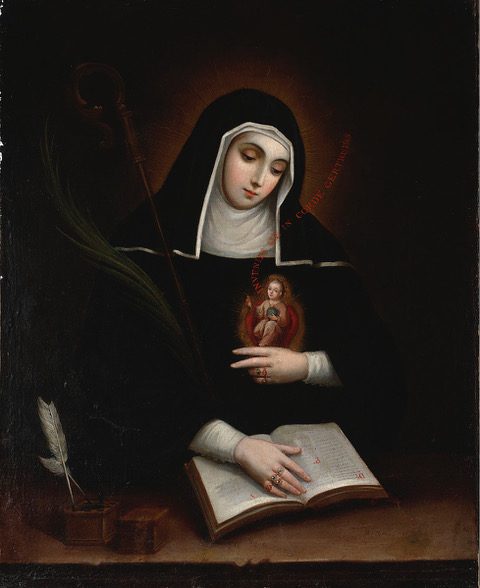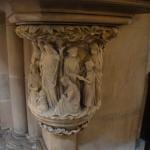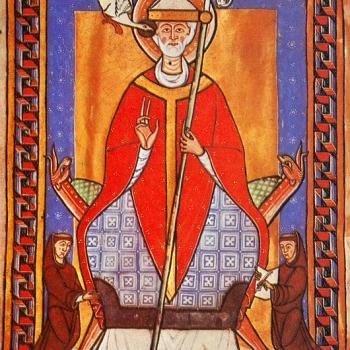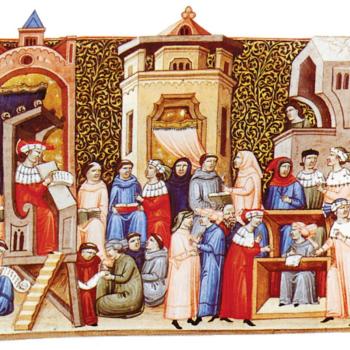Today we welcome a guest contribution from Dr. Jacob Randolph. Jacob Randolph, Ph.D., is a Postdoctoral Research Fellow in the Department of Religion at Baylor University. He is a cultural and religious historian whose research focuses on imagination, gender, and identity formation in medieval and early modern religious communities. His publications appear in Church History, Baptist History & Heritage, and Church History & Religious Culture. His recent article, “Tough and Tender: Theology and Masculinity in the 1991 Baptist Hymnal,” was awarded the 2022 Julian Gwyn Essay Prize in Baptist and Anabaptist History and Thought, Acadia Centre for Baptist and Anabaptist Studies.
“Liturgy is warfare,” the tweet read. “And if the Church had not forgotten that liturgy is warfare, she would never had entertained the horrible notion that women should be ministers. What man sends his wife, daughter, mother, or sister into the front lines of battle? No real man would ever do that.” The quote was not from one of many swashbuckling, “men do hard things” Christo-phallic pop accounts that lurk on the dark corners of Twitter. No, it was from Theopolis Institute, a well-known organization that provides theological resources for liturgically sensitive evangelicals.
As I read this peculiar essay, I was struck by the irony of its short-sightedness, despite being a call to theological retrieval of the old paths. What was it that the Church had forgotten? That spiritual warfare was restricted to men? If anything, the evangelical church has forgotten that women stood on the front lines of spiritual battle beginning with the first Christian martyrdoms. While it is true that women in the Latin West were (almost) never anointed to priesthood, this fact had no bearing on whether women had been sent to the front lines of the spiritual battlefield. In fact, female religious and martyrs in the West were frequently portrayed as milites Christi—soldiers (and later, knights) of Christ. Following the example of Gregory the Great, both male and female medieval religious took Job 7:1 as a sort of motto for their vocation: militia est vita hominis super terram—a person’s life on earth is warfare.
This observation is a nod to a needed historiographical intervention in evangelical spaces. A growing chorus of evangelicals have argued for the retrieval of patristic and medieval sources as a cure for what ails the evangelical church. By observing the continuity of tradition, it is thought, we may more easily see what is novel and potentially heterodox. In many cases, the supposed novelties include expansion of theological language to include genderless or feminine descriptions of God. In other cases, like the Theopolis Institute tweet referenced above, women who assert themselves in traditionally masculine realms are labeled as the enemies of tradition. Modern gender theory has encroached on the unchanging tradition of the church, so they say, and it’s up to the church to align itself with church tradition (i.e., gender dualism and masculine language for God). The problem is that such self-described traditionalists assume too much about the tradition they claim. In the felt urgency of the cultural moment, they glance too quickly and mistake a mirror for a window.
For many medieval authors—especially the experiential mystics or visionaries—it was the colors of religious imagination and not the precision of scholasticism that guided their journeys to the divine. As Barbara Newman writes in God and the Goddesses, “imaginative theology” was dynamic and unsystematic in its approach, using images and the “devices of literature” such as “metaphor, symbolism, prosopopoeia, allegory, dialogue, and narrative” (298). Newman traces medieval Christians’ frequent encounters with feminine divine mediators in a Christianized pantheon. She writes that Christian Platonism, essential as it was for medieval theorizing about the immaterial world, was not restricted to the scientific theologies of scholasticism. Rather, “in medieval imaginative theology, the one God was surrounded by—and manifested through—any number of goddesses…[following] a characteristically Platonic arc of emanation and return” (292). What may be even more astounding to modern readers is that the frequent use of “female God-talk” was not considered notable, much less heretical. “Medieval heresy-hunters,” Newman says, “concerned themselves primarily with threats to ecclesiastical power, secondarily with speculative ideas—and not at all with poetic or devotional imagery. Even if they had been literary critics, however, it is unlikely that representations of Nature, Divine Love, or Wisdom as goddesses, or of Jesus as mother, would have disturbed them” (309). 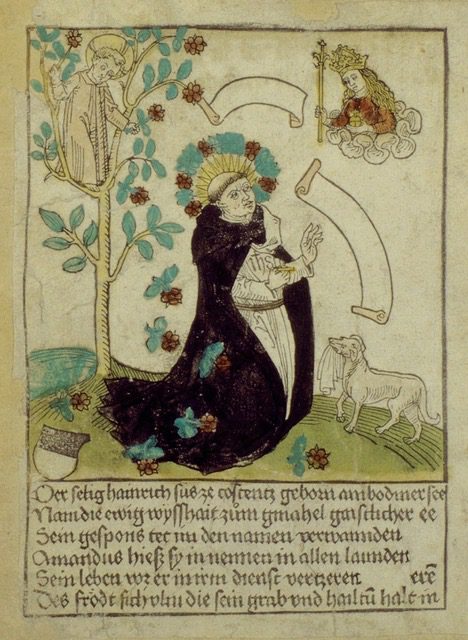
My research deals with the ways that medieval contemplation was culturally embedded. I’m particularly interested in the intersection of feminine depictions of God with that most masculine of enterprises in the medieval period: chivalry. Medieval religious could envision God in female images and erotic innuendo, and women religious often portrayed themselves using intensely masculine images. Chivalry and courtly love energized religious writing in the High Middle Ages, offering a fitting metaphor for spiritual warfare and its goal: the singular pursuit of intimacy with God. Elsewhere, I have written on the fourteenth-century Dominican pastor Henry Suso and his courtly pursuit of Christ in the figure of Sapientia, Lady Wisdom. Here, I’d like to offer one brief example from thirteenth-century Germany that illuminates the interplay between chivalry and devotion to the feminine divine.
Gertrude of Helfta was an influential German Benedictine nun in the late thirteenth century. Her Spiritual Exercises laid down a program of devotion to aid in achieving union with God. The work is written in seven parts following the human life cycle. The first section deals with baptism, the last with death. Some of the prayers of Gertrude illustrate the way that the commingling of chivalric and biblical ideas allowed both divine and human actors to leap from one gendered identity to another. God transitioned from warrior-king to lover-queen; the nun, from pious virgin to powerful knight. In her Spiritual Exercises, Gertrude set out a series of prayers based on the canonical hours. Two prayers illustrate the intersection of chivalry and gendered leaps:
At None, pray to the Lord, the King of kings himself, that he may accept you in the knighthood of love…[praying] O queen of queens, charity, make me, for the sake of your glory, bound to you by oath in the new knighthood (militia) of cherishing you. Teach me to set my hand to strong things and, in you and through you, quickly and unweariedly to go about and fulfill most faithfully the business of your cherishing love. Gird my thigh with the sword of your Spirit, most mighty one, and make me put on virility in my mind so that in all virtue I may act viriliously and energetically…May all my vigor become so appropriated to your charity and my senses so founded and firm in you that, while of the fragile sex, I may, by virtue of a rational soul and virile mind, attain to that kind of love which leads to the bridal-couch of the interior bed-chamber of perfect union with you.
At Vespers, march forward unworried, with Jesus, your lover, in the armor of love against all temptation so that in him, whose mercy always aids and consoles you, you may be able to triumph over your flesh, the world, and the devil…[praying] ‘In me you crush Satan underfoot and bring to naught and utterly cause to flee all kinds of my defects…But let no evil approach me when you yourself are with me, my supreme truth and dearest good. If only, and a thousand times if only your sharp arrows were at last turned toward me so that, struck by the lance of your cherishing love in my viscera, I might, O charity, dwell with exceeding trust in your midst and in you.
These two prayers illustrate Gertrude’s willingness to play in the imaginative space of contemplation, using gender transgression as a tool to inspire devotion to Christ. In the first prayer, virility and the desire to engage in combat were joined together to create the image of an ideal knight of Christ. Female religious ought to desire spiritual battle because it was foundational to their identity. Gertrude and her nuns seek masculine virility so that they may prove themselves and their love, and by doing so enter into intimate knowledge of the feminine divine, Charity. In the second prayer, Gertrude prays that Christ would be her armor so that she would not fall to her enemies. But immediately she turns the metaphor inside out; now Christ is pictured in opposition to Gertrude as a combatant. His love is so intense as to be almost adversarial. Whereas she wished to conquer diabolical foes, her desire is also to fall in battle against Christ and so be taken into him. The courtly imagery is clear: In the recitation of these prayers, Gertrude and all who followed her became knights subservient to Lady Love, the goddess of medieval theologians who was herself God.
So what do medieval Christians like Gertrude change for the debates over gender in evangelicalism? Simply put, Gertrude’s masculinized devotion to a gender-bending deity—which was a commonplace in medieval Christianity—gets in the way of unilateral claims about gendered language for God and an overly-dualistic approach to masculinity and femininity. This hiccup, I think, has at least three broader implications for the evangelical retrieval project. 1) If evangelicals are going to journey to the distant past of medieval Christianity for theological retrieval, they must be willing to live with what they might find there. Historical nuance and variation must be recognized, even (especially) if they come at Tradition’s expense. 2) There should be a healthy suspicion of narratives of continuity and universality. Such narratives depend on a selective and subjective elevation of the propositional and scholastic over the mystical and pastoral. Such selectivity leaves out the voices of essential participants in the developments of medieval theology, especially women religious. Conversely, attention to mystical and pastoral theology can open new doors for theological dialogue between modern and medieval Christians. 3) If they linger too long in the past, self-described traditionalists may find that their approach is the novel one. In the end, perhaps we can say two things simultaneously: that history can be a rich resource for theological renewal, and that history is often a fickle ally in any evangelical mission to align with Tradition.


